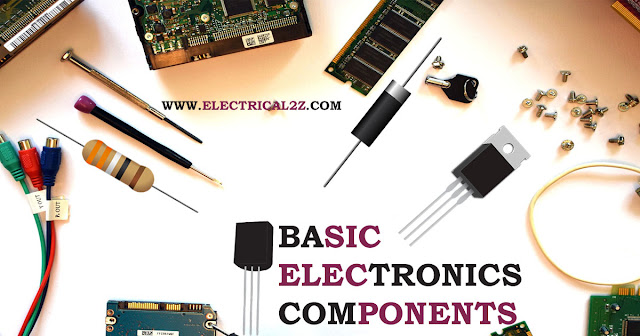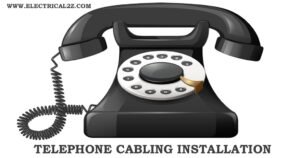Basic Electronics Components | Electronics got its start with the invention of the vacuum tube. A vacuum tube has the ability to rectify and to amplify. Edison was experimenting with his first electric lamp when he discovered that the frequent burning out of the carbon filament near the positive end produced a black deposit inside the bulb and a shadow on the positive leg of the lamp filament.
He tried to remedy the condition by placing a metal plate inside the lamp near the filament and connecting it through a galvanometer to the filament battery. When the positive terminal was connected to the metal plate, a deflection of the galvanometer was observed. When the plate was connected to the negative terminal, there was no deflection of the galvanometer. Edison recorded these effects in his notebook but did not pursue the phenomenon.
Sir J. J. Thomson, an English physicist, discovered the electron around the turn of the century. Once the electron was discovered and defined, it was an easy task to describe what happened during the “Edison effect.” Electrons escaped from the heated carbon filament and, being negatively charged, moved freely through the vacuum to the plate when it was connected to the positive battery terminal.
However, when the plate was negative, the electrons were repelled, and no deflection was observed on the galvanometer. The vacuum tube diode was the first device to take advantage of the Edison effect. It was made to rectify alternating current (AC) that is, to change the AC to direct current (DC).
Table of Contents
Basic Electronics Components
 |
| Basic Electronics Components |
Diodes | Basic Electronics
There are two types of diodes. One is the vacuum tube diode, and the other is the semiconductor diode. Both types possess two elements:
a cathode and an anode. These elements have polarity. A cathode in a vacuum tube is labeled negative (–), and the anode positive (+). In a semiconductor device, the cathode is positive, which is indicated by a ring around one end of the diode. Both types of diode serve the same functions: They rectify current and they are used for switching operations.
Diodes can also be broken down into two other groups power diodes and signal diodes. Power diodes handle large power requirements in power supplies and they are used to change AC to pulsating DC. They can be either vacuum tubes or semiconductors. Signal diodes are smaller than power diodes and may be either vacuum tubes or semiconductors. As semiconductors, they are very small and encapsulated in plastic or glass.
 |
| Basic Electronics Components 1.1 |
Rectifier Diodes
The actual size of these semiconductor diodes is small, but they can handle up to 6 amperes at 400 volts and are very inexpensive. When properly used in circuits that do not exceed their ratings, they will last for many years. Rectifier diodes are identified by three or four numbers with a 1N or MR prefix.
Bridge Rectifiers
Bridge rectifiers are made up of four diodes. They produce a full wave rectification so that both halves of the wave are utilized in power supplies. They are found in many devices from battery chargers to meters. Many electrical power supplies have bridge rectifiers. They are packaged in a variety of forms.
Diacs
This device [diode (two-element) AC switch] is used in switching amplifier control systems. It is used in combination with a triac to serve as a light dimmer and to regulate the speed of electric motors.
The diac is made specifically to trigger triacs, but is also useful in conjunction with silicon-controlled rectifiers. It will trigger with either positive or negative pulses.
Silicon Controlled Rectifiers (SCRS)
These are also called thyristors. They have many uses, such as for speed controls, light dimmers, and many other control circuits.
Triacs
The triac [standing for triode (three-element) AC switch] can be triggered by positive and negative gate signals and conducts during both halves of the AC cycle. This device is used in level controls, light dimmers, and speed controls for motors.
Switching and Signal Diodes
These diodes are for small currents and voltages less than 100. They can be found in many older devices of the germanium type. Switching diodes are used for computer and control circuits.
Zener Diodes
This type of diode is used for voltage regulation and is found in almost every piece of industrial and commercial electronics equipment or control device. The Zener is also prefixed with a 1N designation. Wattage ratings are from 400 milliwatts to 5 watts.
Be sure to obtain the right wattage rating if you want the diode to operate without burning up. Zener diodes resemble the standard rectifier diode in appearance. However, the symbol for the zener is slightly different, so it can be spotted on a schematic.
 |
| Basic Electronics Components 1.2 |
Integrated Circuits(ICS) | Electronics Components
A single, monolithic chip of semiconductor was developed in 1958. J S. Kilby was responsible for its fabrication. Active and passive circuit elements were successively diffused and deposited on a single chip. Shortly afterward, Robert Noyce made a complete circuit in a single chip.
This led the way to the modern, inexpensive integrated circuits. Resistors, capacitors, and transistors, as well as diodes, can be placed on a chip. Diodes can be arranged in many groups to do different things.
Photolithography, a combination of photographic advertisement printing techniques, has been used to aid in the layout of the diode arrangement and has made it possible to mass produce sophisticated devices with high reliability.
Integrated circuits are packaged in a number of types of ceramic and plastic cases. They may have four or as many as 48 pins. The identification of the pins starts with the notch in the top of the case. Usually it will also have a dot on top to indicate the No. 1 pin.
Integrated circuits are relatively standardized. This is partly to take advantage of mass-production techniques. Standard components and connections are needed if the finished electronic equipment is to be low in cost.
Large numbers of ICs are used in computers and calculators, as well as in television and other communication equipment. They are small and very reliable, and they consume little power. It is possible to obtain ICs with large memory capacities. Thousands of electronic elements may be placed on a single chip; this is done through a method known as large-scale integration (LSI).
Robotics uses electronics. Electricians wire the installations and are responsible for getting power to the control consoles. Inside the consoles are many types of ICs. Their identification may be very useful. Check catalogs for the right ones for the particular job.
In some cases, an IC has been created and manufactured for a specific piece of equipment. Manufacturers’ numbers, have to be obtained from the top of the chip in order to replace it with the correct substitute.
Optoelectronic Devices | Basic Electronics
Optoelectronics has been used in many industrial and commercial operations. Displays are used everywhere to indicate calculator results, cash register amounts, weights on digital scales, and readouts on digital meters.
Photo diodes, infrared-emitting diodes, and photo detectors, as well as phototransistors, reflective object sensors, and infrared light-emitting diodes (LEDs) are used in industry in control devices. Many of these are also used in fiber optics through which telephone messages are transmitted and received.
Displays | Electronics Components
The seven-element LED display comes in five sizes. This type of display produces light and can be used where there is no ambient light. It usually glows red. Optoelectronic displays are used wherever a sturdy readout is needed. They can be replaced if soldered in place or in sockets. The right size is important when trying to locate a replacement.
Liquid crystal displays (LCDs) need ambient light in order to be seen. They do not use much energy, working with microwatts of power, whereas the LED display that glows brightly enough to be seen in the dark or daylight draws more energy in terms of milliwatts.
Light-emitting diodes are available with either common cathodes or common anodes. In the former (common cathode) case, particular segments are energized when a positive voltage is applied to them, with the remainder “down.” In the latter (common anode) case, energized portions are “high,” and those portions to be energized are “low,” i.e., at 0 volts. A 7447 decoder is needed to illuminate the appropriate segments of the display.
Light-Emitting Diodes(LEDS)
The light-emitting diode is used for indicator lights, calculator numerical displays, and computer display systems. The LED is a PN junction diode, operating in a forward-biased mode. Recombination of electrons and holes release the stored energy in the excited electrons.
The P-type gallium arsenide LED must be made very thin for efficient light output. Electrons are pumped up by an externally supplied direct current. LEDs are used as infrared sources for many sensing operations in industry. Along with reflective object sensors, they can be used to count and do quality control operations. The photo sensor responds to infrared radiation from the LED only when a reflective object is within its field of view.
Optical Couplers
The triac-driven opto-couplers each contain a gallium arsenide or gallium aluminum arsenide infrared-emitting diode coupled to a photodiode and a zero-voltage bidirectional triac driver mounted in a standard six-pin dual inline package (DIP), the type ICs use.
These devices are intended to be used for low-power DC control of power triacs, which in turn control resistive, inductive, or capacitive loads powered from the 120-volt AC or 220-volt AC with required LED drive currents of 30, 15, 10, or 5 milliamperes.
Zero-voltage crossing ensures that the device will not turn on until the line voltage reduces to 15 volts for the 120-volt devices and 25 volts for the 220-volt devices.
 |
| Electronics Component |
Transistors
Transistors are semiconductor devices made from N- and P-type crystals. Once joined, the two different types of crystal produce junctions. Transistors are identified according to emitter junction and collector junction.
A PNP transistor is formed by a thin N region between two P regions. The center N region is called the base. This base is usually 0.001 inch thick. A collector junction and an emitter junction are also formed.
NPN and PNP transistors are the two most popular types. The main difference between the two transistors is in polarity. Polarity can be recognized by pin locations on transistors. Pin designations for specific transistors are found in a transistor handbook.
The important thing to remember in transistor circuits is polarity and voltage. The polarity of the voltage is very important in the proper operation of the transistor. NPN and PNP types differ only in their polarity.
 |
| Circuit Board |
Surface-mounted technology has increased efficiency and lowered the cost of integrated circuits for control circuits and computers.
Final Word
Hope you understand this article about Basic Electronics Components. Incase of any doubt please comment below. Subscribe our website to get every new post update to your email. Please follow our website – ElectricianWorld.net for future updates. Thank you for visiting our website.



